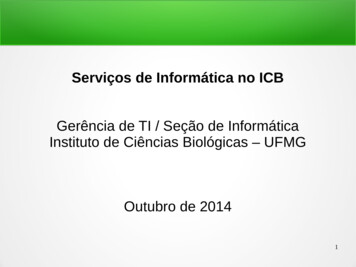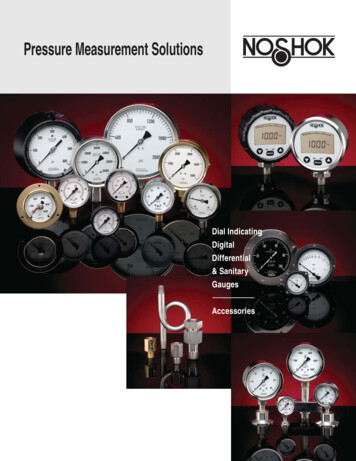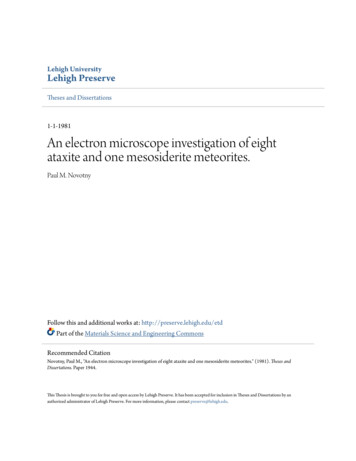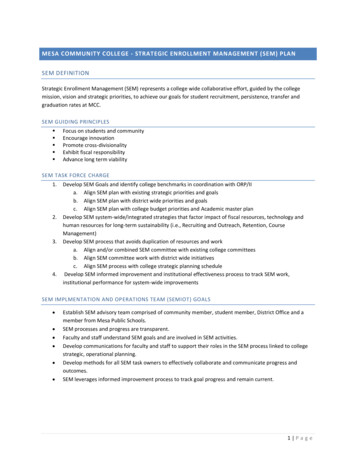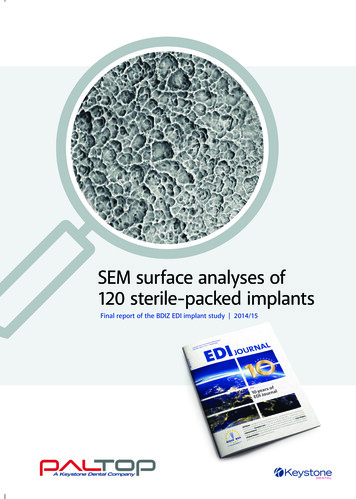
Transcription
SEM surface analyses of120 sterile-packed implantsFinal report of the BDIZ EDI implant study 2014/15
1CLINICAL SCIENCEFinal report of the BDIZ EDI implant study 2014/15SEM surface analyses of120 sterile-packed implantsDR DIRK DUDDECK1,2, DR HASSAN MAGHAIREH3, DR FRANZ-JOSEF FABER4 AND DR JÖRG NEUGEBAUER1,5EDI Journal 1/2015 contained an interim report presenting the results for 65 implant systems from the 2014/15BDIZ EDI implant study. This interim report had focused on notable analytical results for titanium implants andon the presentation of various surface structures of popular implant systems in titanium and its alloys [1]. Thepresent report now also presents implants made of zirconia, tantalum and PEEK. Now that this study has beencompleted, a total of 120 different systems from 83 suppliers in 16 countries have been examined by scanningelectron microscopy, doubling the number of implant systems analyzed by the BDIZ EDI Quality and ResearchCommittee since the first study in 2008 [2,3]. In cooperation with the University of Cologne, extensive materialcontrast images were obtained and qualitative and quantitative elemental analyses performed on each of theimplants examined, using the same study protocol.Dental implants are an integral part of the therapeutic armamentarium of contemporary dental practices. With their excellent success rates, they havebecome the globally established treatment alternative to purely prosthetic solutions for tooth loss.And with the variety of implant systems offered,it has become ever more difficult for the dentist tochoose just the right system for his or her practiceand patients. Specific surface topographies, materialproperties that promote osseointegration or surfacetreatments are often emphasized in advertising assignificant advantages to distinguish a given systemfrom its many competitors. According to the Association of German Dental Manufacturers (VDDI), morethan 1,300 different implant systems are currently1available worldwide. Northern Italy alone probablyhas a hundred micro-enterprises that manufactureimplants, primarily for regional dentists. But eventhough only a fraction, namely 120, of all the implantsystems available in Europe could be included in thisstudy, these represent the most important brands ormajor suppliers of implants.Background and objectivesThere is commonly a significant discrepancy betweenthe responsibility treatment providers must assumefor the materials they use vis-a-vis their patients andtheir knowledge regarding the quality of these materials as confirmed by neutral and scientific sources.As stated in the interim report in the previous issue, Interdisciplinary Policlinic for Oral Surgery and ImplantologyDepartment of Oral and Maxillofacial Plastic SurgeryUniversity of CologneDirector: Professor Joachim E. Zöller · Kerpener Straße 32 · 50937 Köln · Germany2Medical Materials Research Institute Berlin · Klingsorstraße 116 · 12203 Berlin · Germany3Clinical Teaching Fellow, University of Manchester · Implant Referral Practice – Leeds, UK · 9 Woodhouse Square · Leeds LS31AD · England4Centre for Dentistry and Oral and Maxillofacial Surgery, University of Cologne, Materials Science/Dental Materials Research ·Kerpener Straße 32 · 50931 Köln · Germany5Dental Group Practice Dr G. Bayer, Dr F. Kistler, Dr S. Kistler, Dr A. Elbertzhagen, Dr J. Neugebauer · Von-Kühlmann-Straße 1 ·86899 Landsberg am Lech · Germany
23CLINICAL SCIENCECLINICAL SCIENCEOK to use in patients –but apparently not always OK to take a closer lookThe great majority of manufacturers responded positively to the requests by the University of Cologne. Nevertheless, somemanufacturers declared that they had no interest in this study. Not even the proclaimed fact that the present study did notprimarily emphasize the producers’ interests but rather those of the users caused them to reconsider.In a few cases, orders for implants to be used for the purposes of this study were not filled and delivery was refused – eventhough these implants are used by several hundred practitioners throughout Europe (see box “Appeal to readers”). Especiallynoteworthy was the response from one manufacturer stating that one could not remember ever havingreceived requests from users for SEM images or EDX results. Dentists, the statement continued, assumed that these resultswere good as a matter of course. Or else they were not interested in this information. And even if they were, they would notknow how to interpret the data correctly anyway. Less favourable results could be surpassed by the competition; and evengood results were no “seller”, because they were not properly understood by the reader. Thus, the risk of misinterpretation faroutweighed any benefits of the study. All relevant information and a variety of studies on the requestedimplant system, they concluded, could be downloaded from the company’s website. In fact, the website offered noevidence on the safety of the chromium-nickel-steel particles that were found en masse in this study on an implantby that manufacturer. Unsurprisingly, therefore, the sterile-packed implant analyzed in this study was not providedby the manufacturer.1 ISDS – Metoxit (x 500).123456782 ISDS – Metoxit(x 2,500).3 Ivitaclinical(x 500).4 Ivitaclinical(x 2,500).Another manufacturer explicitly did not want to participate in the study, but had then decided to fill the order for a sample implant and not to participate in any boycott. However, the shipment contained an invoice and an explicit note to the effect thatthe implant was not to be named in any publication related to the present study. We acknowledged that desire, but we did notwant to deprive our implantological colleagues of the results. Because if the implants are good enough to be used in patients,they should be good enough to present in an SEM image.Are we implantologists really not interested in the quality of the systems we use? Are we unable to evaluate the results ofthis study? Do some manufacturers have to “protect” us from scientific studies because we cannot interpret them correctlyanyway? Users will be able to answer these questions readily after reading this report.5 IDentalpoint –Zeramex (x 500).6 IDentalpoint –Zeramex (x 2,500).CE marks do not protect the market, or rather thepatient, from substandard quality in medical devices[4]. An international group headed by the Universityof Geneva School of Dental Medicine has embarkedon the highly commendable quest to characterize,classify and code dental implants starting in 2010 –the so-called Implant Surface Identification Standard(ISIS) that might facilitate the future introduction of apossible ISO standard for dental implants [5,6].The surface quality of implants depends on anumber of different factors. Once the titanium implant blank has been CNC-machined, it is furtherprocessed using different techniques that ultimatelyresult in the product’s specific surface structure.The various processes used for titanium implantswere discussed in the first part of the report. Various production processes ultimately contribute toproduct quality: the production itself, the cleaningsteps, post-production handling (i.e., quality control),packaging and sterilization processes and the packaging itself.A striking feature of this study has been the manydifferent types of sterile packaging that sometimesgo to considerable lengths to prevent any kind ofcontact of the implant with the packaging. In fact,several implants in the study that did not fea-ture contact-free packaging but were delivered insoft sealed polyethylene bags exhibited variousamounts of organic contaminants or plastic residue,depending on their surface roughness.As described in the interim report, even a wellstructured implant surface proven in clinical practice for many years may accumulate not insignificant amounts of organic contaminants or plasticparticles through abrasion, unless the implant wasdelivered in non-contact packaging. There havebeen reports in the literature that these organiccontaminants are associated with early implantloss or with peri-implantitis [7]. The documentedamounts of carbon in the regions that are alreadyobvious on the material contrast images are considerably higher than the minor amounts of carbonadsorbed from ambient carbon dioxide as presenton any titanium implant. The more or less sophisticated technical implementation of the sterile packaging has no direct relation to the price of the implants. But how far can we let manufacturers go intheir drive to save cost if the result is sharp-edgedcover screws that damage, and thereby breach, thesimple sterile packaging even before they are used(see the text box on sterile packaging on page 75)?In addition to the previously presented implant7 IZibone – Coho(x 500).8 IZibone – Coho(x 2,500).systems made of titanium and titanium alloys, implants made of zirconia, tantalum and polyetherether ketone (PEEK) were also studied.Zirconia as an implant material has been provenfor many years. It is probably in no way inferior totitanium or titanium oxide in terms of its osseointegration potential [8]. The surfaces exhibit differentlevels of roughness (Figs. 1 to 16).The specific removal torques – the forces necessary to split up the bone-implant interface by unscrewing the implant once osseointegration has taken place – do not differ between zirconia implantsand titanium implants of similar roughness [9]. Occasionally observed cases of lost zirconia implants
45CLINICAL SCIENCE9CLINICAL SCIENCE9 IAxis – biodental(x 500).1010 IAxis – biodental(x 2,500).1111 IBredent – WhiteSky(x 500).1217 I Trabecular midsection made of tantalum(Zimmer Trabecular Metal implant, x 500).12 IBredent – WhiteSky(x 2,500).13limetres of the prepared implant site [10].One tantalum-titanium hybrid implant in thisstudy exhibited a rather particular surface topography. While the titanium surface of the implantshoulder and its apical region had been blastedwith hydroxyapatite, the middle segment of the implant, marketed by the manufacturer as “trabecularmetal”, had a porous structure not unlike cancellousbone. This three-dimensional structure is based ona glassy carbon framework completely coated withtantalum. The corrosion-resistant tantalum [11] hasbeen successfully used as an orthopaedic implantmaterial for many years. Now also used in dentalimplants, the special surface texture is designed toallow the ingrowth of bone cells into the depth ofthe structure [12,13]. The term “osseoincorporation”has been coined in the literature in an attempt toadd a third dimension to Brånemark’s definition ofosseointegration [14]. Prospective multicentre studies at 22 locations in five European countries haveshown that the clinical success rates of hybrid implants made of titanium and tantalum were similarto those of pure titanium implants [15]. The onlyrepresentative of this class of materials in the currentstudy was the tantalum-titanium hybrid implant byZimmer (Figs. 17 and 18).13 IZ-Systems – Zirkolith(x 500).1414 IZ-Systems – Zirkolith(x 2,500).1515 INatural DentalImplants – root-analogue replicate madeentirely of zirconia(x 500).1616 INatural DentalImplants – root-analogue replicate madeentirely of zirconia(x 2,500).may not be solely due to the surface properties ofthese implants. One possible cause of early implantloss may be the low thermal conductivity of zirconia.Thus, the thermal conductivity of yttrium-stabilizedzirconia, at approximately 2.2 Wm–1K –1, is nearlyten times lower than that of grade 4 titanium (22–1 –1Wm K ) and three times lower than that of grade–1 –15 titanium (Ti-6Al-4V) at 6.7 Wm K . Inserting zirconia implants at the torques commonly used for titanium implants might result in temperature peaks,especially in high-density bone, that could causethermal bone damage. In-vitro studies have shownthat elevated insertion torques lead to a significanttemperature increase, especially in the first few mil-18 I The shoulder and apex of the same implant are made of titanium (Zimmer TrabecularMetal implant, x 500).20 I3D roughness reconstruction (BredentWhiteSKY, x 2,500).19 I Implant made of polyether ether ketone(Champions WIN! PEEK implant, x 500).Polyether ether ketone (PEEK) has more recentlybeen used as a new material for dental implants (Fig.19). As the material has only been used for dentalimplants for a rather short time, only few reports areextant. In-vitro trials suggest that the mechanicalproperties of PEEK might optimize the distribution ofmasticatory forces through the implant’s surroundings [16,17]. Here we will have to wait for long-termclinical results. Only one implant made of PEEK wasincluded in the study; a second manufacturer hadnot responded to our enquiries.Materials and methodsA total of 120 different implant systems from83 manufacturers and 16 countries were analyzedby scanning electron microscopy (Table 1). TheSEM device used for the acquisition of the surfacetopography (Phenom proX, Phenom-World, Eindhoven, Netherlands) has a highly sensitive detector for backscattered electrons (BSE) that facilitatesinferences about the composition of the examinedmaterial as the so-called material contrast imageemerges. Elements with a low atomic number, i.e.with fewer electrons, such as carbon or aluminiumare shown as relatively dark areas, while elementswith high atomic numbers such as titanium or zirconium appear relatively bright.For testing, the implants were taken out of theirpackaging using a sterile forceps and attached tothe sample holder before being introduced intothe vacuum chamber. Because zirconia implantsare more easily electrically charged than titaniumimplants, a so-called charge-reduction sampleholder was used that largely attenuates this charging phenomenon, which would otherwise lead toartefacts.Qualitative and quantitative elemental analysis ofthe implant surfaces was performed using energy-
67CLINICAL SCIENCECLINICAL SCIENCETable 1: List of implant manufacturers participating in the 2014/15 implant study (as per 30 April turerCountrySwitzerlandABIsraelDentatus – LoserSwedenNBM3M EspeGermany/USADentaurumGermanyNeossUnited KingdomAdinIsraelDentegrisGermanyNobel BiocareSwedenAGS ImplanceTurkeyDentiumKoreaNucleossTurkeyAlpha-Bio TecIsraelDentsply ImplantsSweden/GermanyOCO BiomedicalUSAAlpha DentUnited KingdomDioKoreaOsstemKoreaAlphatech(Henry Schein)GermanyFairImplantGermanyOT medicalGermanyGeneral USAPhiboSpainArgon inIDIFranceProwitalGermanyAxis biodentalSwitzerlandImplant ental CSwitzerlandSouthernSouth AfricaStraumannSwitzerlandSweden ZL-MicrodentGermanyBiohorizonsUSAKeystoneUSABiomet 3iUSAKlocknerAndorraBiotek BTKItalyKSI ym sGermanyCamlogGermany/SwitzerlandMedical atural DentalImplantsCumdenteGermanyNature ImplantsGermanyDENTAL Clinical HouseSwitzerlandCortexAn updated list of all investigated implants and comprehensive reports on individual implants (upto three reports per request) are available to BDIZ EDI members by contacting the association office(office@bdizedi.org).dispersive X-ray spectroscopy (EDX). Here, the electron beam causes the primary electrons emitted tointeract with the atoms of the specimen surface,releasing electrons of the inner shell as “secondaryelectrons”. The resulting gaps are immediately filledby electrons from a higher orbital. The difference inenergy is emitted as an X-ray quantum and detectedby a thermoelectrically cooled detector, measuringboth the elemental compositions and their concentrations. An areal analysis and one or more spotanalyses (in case of irregularities) were performed foreach implant.To document the surface roughness of each of theinvestigated implant systems, a so-called 3D roughness reconstruction was performed that allows a visual comparison of the respective surface structures.During the imaging process, the three-dimensionalshape of the object is calculated from the brightnessdistribution in the grid of the four quadrants of thebackscattered electron detector (Fig. 20).21 I “Single spot”, individual organic contaminant (x 2,500).23 I Organic residue on the outer threadstructures (zirconia, x 500).24 I Superficial organic particles(zirconia, x 500).ResultsMinor amounts of carbonaceous residue remainingon the implant after the cleaning process are a notinfrequent finding. Organic residue appears darkerin the material contrast image than titanium or zirconia because carbon atoms have fewer electronsand therefore create fewer backscattered electronsin a SEM than atoms of higher atomic numbers. Soft,sometimes jagged edges are typical of organic contaminants. If there are only a few isolated spots likethat, they will make up only a very small part of thetotal area, being of little consequence and no clinicalrelevance (Fig. 21). The figure shows a single organicimpurity 10 to 20 µm in size on an otherwise largelyresidue-free implant. More conspicuous were systematically distributed organic residues on severalimplants that are in contact with their outer packaging. These typically featured circumferential organiccontamination occurring only at the outer edge ofthe thread (Figs. 22 to 24), which suggests that con-22 I Circumferential organic residue on atitanium implant (x 500).25 I Individual inclusions of sandblastingmaterial (titanium, x 2,500).tact with the packaging could be responsible.Some isolated implants exhibited inorganic residue from the sandblasting process, namely aluminaparticles 20 to 30 µm in size (Fig. 25), but in quantities of presumably limited clinical relevance.Unexpected inorganic residue findings included,in addition to the iron-copper-chromium particlesdescribed in the first part of the report, larger areaswith intermittent chromium-nickel-steel particles 4to 30 µm in size on one of the implants studied. Thematerial contrast image had already presented themas strikingly bright and well-defined structures. Thesemetallic particles might have originated as impuritieswithin the blasting material or as abrasion residuefrom the CNC cutting tools that were subsequentlyembedded in the implant surface to the point wherecleaning could not remove them (Figs. 26 and 27).Three spot analyses were carried out as part of thequalitative and quantitative elemental analysis (Fig.28). The analysis of the chromium-nickel-steel particle
89CLINICAL SCIENCE26 I Implant surface (Adin Touareg) withnotable light and dark particles (x 500).CLINICAL SCIENCE27 I Same implant surface (Adin Touareg):bright chromium-nickel-iron particle, darkaluminium oxide particle (x 2,500).28 I Marks for EDX spot analysis andEDX mapping area (Adin Touareg; x 2,500).Atomic percentageFeTi29 I Qualitative elemental analysis, spot no. 2 (bright chromium-nickeliron particle).49.8%13.6% 0.9937 I Dentium – Superline (x 2,500).38 I Nucleoss – T4 Implant (x 2,500).39 I Osstem – TS III (x 2,500).40 I Phibo – Aurea (x 2,500).Table 2 I Quantitative elemental analysis – Element distribution,spot no. 2.Certainty68.2%0.99Al25.3% 1.00Ti6.1% 0.99V0.4% 0.93Table 3 I Quantitative elemental analysis – Element distribution,spot no. 3.Atomic percentageTi(spot no. 2) has typical “fingerprints” for the elementsiron, nickel and chromium (Fig. 29 and Table 2). Asexpected, the dark particle turns out to be alumina(Fig. 30 and Table 3), while the control area outside36 I C-Tech – Esthetic Line (x 2,500).5.2% 0.961.3% 0.94Atomic percentage31 I Qualitative elemental analysis, spot no. 4 (particle-free implantsurface, grade 5 titanium).35 I Avinent – Ocean (x 2,500).0.995.6% 0.97O30 I Qualitative elemental analysis, spot no. 3 (bright aluminium oxideparticle; sandblasting residue).34 I Argon Medical – K3Pro Sure (x 2,500).24.5% 0.99AlV33 I AlphaBio – SPI Spiral Implant (x 2,500).CertaintyCrNi32 I Example of EDX mapping: green chrome;blue aluminium (Adin Touareg; x 2,500).Certainty85.7%1.00Al11.5% 0.99V2.8% 0.94Table 4 I Quantitative elemental analysis – Element distribution,spot no. 4.the two particles (spot no. 4) shows only the typicalsigns for grade 5 titanium (titanium, aluminium andvanadium) (Fig. 31 and Table 4).The so-called EDX mapping assigns each elemen-tal signal its own colour, which can then be superimposed on the SEM image as a coloured overlay.Figure 32 shows the detected chromium in greenand aluminium in blue.Fortunately, the vast majority of the studied im-plants exhibited no significant contamination. Byway of example, the surfaces of titanium implantsby some manufacturers (Alpha-Bio, Argon Medical,Avinent, C-Tech, Dentium, Nucleoss, Osstem, Phibo, SGS and Bredent) are presented at comparable
1011CLINICAL SCIENCECLINICAL SCIENCELimitations of SEM resolution –Or: How clean would you like it?41 I SGS – Pi (x 2,500).42 I Bredent – BlueSky (x 2,500).43 I Camlog – Conelog (x 500).Atomic percentageTiCertainty100.0%1.0046 I Paltop Advanced Dental Implant (x 500).47 I Paltop Advanced Dental Implant (x 5,000).The scope of elemental analysis by energy-dispersive X-ray spectroscopy (EDX) as used in this study is limited because itdoes not detect superficial contaminations on the nanoscale. As the electron beam impacts the implant, it is scattered in thesample, so that the emitted X-rays form a pear-shaped volume having a diameter of 0.1 to 2 µm. Thus, signals originating inthe top few nanometres of an implant surface are extinguished by deeper signals.44 I Camlog – Conelog, EDX area analysis (x 2,500).magnification in Figures 33 to 42. The continuousimprovement process in Camlog implants deservesspecial mention. While the samples analyzed in 2008showed residues of blasting material on up to tenper cent of the total surface, the figure for 2011 wasless than three per cent for the same implant type. Inthe current study, all three implant models (Camlog,Conelog and iSy) exhibited completely residue-freesurfaces in the elemental analysis. Thus, the spectrum of the EDX analysis of the Conelog implant surface indicates only titanium (Figs. 43 to 45).DiscussionThe clinical relevance of minuscule particles andcontaminants on dental implants is a matter of debate. Even the manufacturers of implants on whoseimplants more or less large amounts of organic orinorganic contaminants were found in tests havereported statistical success rates that are not different from those of other implants, proving their point45 I Quantitative and qualitative elemental analysis of the CamlogConelog implant surface (pure titanium).with specially conducted studies.Up to a point, biocompatible aluminium oxide residues are unlikely to affect the bone-implant contact(BIC) [18,19]. But how does the human body handlepolyethylene or chromium-nickel-steel particles?Even if these particles are relatively firmly attachedto the implant surface, they are likely to become detached by the resulting frictional forces in the bonebed as the implants are inserted at torques in thedouble digits to achieve the desired level of primarystability.Particles with a diameter of less than 10 µm aresusceptible to uptake by macrophages throughphagocytosis [20], so that questions related to theclinical relevance of such impurities cannot simplybe brushed aside. From orthopaedics it is knownthat particle-induced macrophage activation is associated with an increased osteoclastogenesis andmay therefore cause increased bone resorption [21].One point of criticism that has been repeatedlyOnly X-ray photoelectron spectroscopy (XPS) can produce such sensitive evidence in layers 5 to 10 nm in thickness.The kinetic energy of the photoelectrons of an atom is measured to determine its binding energy, which is characteristic of theatom from which the electron emanates. This can be used to determine whether the cleaning process after acid etching of theimplant surface has left traces of acid or if the water used for the cleaning itself was clean enough.An Israeli manufacturer (Paltop) has decided to consistently clean their products with ultra-pure water (UPW), whichis rather expensive to produce compared to regular demineralized water and is otherwise mostly employed by thesemiconductor industry. XPS analyses of the implant surfaces thus cleaned show no traces of sulphur, silicon, zinc orchlorine, inorganic impurities not infrequently found in the XPS analyses of the sandblasted and acid-etched surfaces ofimplants by other manufacturers investigated in 2014 as the corresponding ISIS identification cards were prepared [22]. Thematerial contrast image showed no residue on the Ti-6AL-4V ELI implant (Figs. 46 and 47). The corresponding EDX analysisshows only the typical elements for grade 5 titanium (Fig. 48 and Table 5).Atomic percentageTiOCertainty65.6%1.0024.4% 0.96Al7.3% 0.99V2.7% 0.9648 I EDX spectrum for the Paltop implant.Table 5 I Quantitative elemental analysis of the Ti-6Al-4Vexpressed by some manufacturers in the context ofspecimen used in this study patterns are only random samples. A scientific study requires at least fiveto seven implants of each implant type to make statistically valid statements about a quality standard.But the reply can only be that those implants aremedical devices where – unlike with general technical goods – defects cannot be remedied or “repaired”once inserted. Each of the implants examined wassterile-packed and intended for use in patients.One might therefore counter by asking why themanufacturers’ quality management is obviously
12CLINICAL SCIENCESterile packaging – bedchamber of implants:from simple and non-sterile to elaborately protectedWhile a limited number of technologies has now takenover the manufacturing of implants, the ingenuity ofmanufacturers in packaging their implants apparentlyknows no limits. The studied implants represented a widevariety of designs, where aspects such as ease of use, safetransport, contamination-free storage and productioncosts appeared to be in competition.On the one hand, there are uncompromising elaborateconstructions that offer safe handling and are sure toeat into the manufacturer’s profit margin (Fig. 49). Theillustration shows a complex packaging design where theimplant is inserted in a separate sleeve made of the samematerial (grade 5 titanium) as the implant itself to reducethe influence of other materials to a minimum.On the other hand, there are simple packaging solutionswhere the implant is simply sealed in a double plasticbag and the manufacturer seems to have deemed even astabilizing outer wrapper such as a blister pack to be toocostly. Figure 50 shows a sterile package compromised bya sharp-edged cover screw.subject to daily fluctuations and why implants arereleased which yield suboptimal results in individualtesting.Each day we are tasked with winning the trust ofour patients, and each time we perform an implantological treatment we are trying to prove worthy of thistrust. For individual manufacturers to reject studies likethe present one or to allege image manipulation is notparticularly helpful in this endeavour. But the vast majority of the studied implants presents an encouragingpicture. By far most manufacturers are aware of theirresponsibility and provide implantologists in Europewith solidly made systems. To find the list of references visit the web (www.teamwork-media.de).Follow the link “Literaturverzeichnis” in the left sidebar.Contact addressDr Dirk DuddeckInterdisciplinary Policlinic for Oral Surgery andImplantologyDepartment of Oral and Maxillofacial Plastic SurgeryUniversity of CologneDirector: Professor Joachim E. ZöllerKerpener Straße 62 · 50937 Köln · Germanydirk.duddeck@gmx.de49 I Example of elaborate sterilepackaging, longitudinal section(Paltop).50 I Sterile packaging compromised by asharp-edged cover screw (BlueSkyBio).Appeal to readersWe would have liked to be able to present resultsfor implants by the following manufacturers:· Ihde Dental (Switzerland)· MozoGrau (Spain)· SHINHUNG (Korea)· Etgar Implants (Israel)· Signo Vinces (Portugal/Brazil)Despite several reminders or placement of a regularorder, these implants could not be analyzed.If you are a user of implants by these manufacturersand as interested as we are in the results, please mailus at duddeck@bdizedi.org.
www.paltopdental.cominfo@paltopdental.com154 Middlesex TurnpikeBurlington, MA 01803Phone: 1-781-328-3600www.keystonedental.comVertrieb / DistributionDeutschland, Belgien,Niederlande, Luxemburg,Frankreich:RUNDAS GmbHAmalienstr. 6246537 DinslakenTel.: 02064 625 95 50Fax: 02064 625 95 80E-Mail: info@rundas.deInternet: www.rundas.de
EDI Journal 1/2015 contained an interim report presenting the results for 65 implant systems from the 2014/15 . BDIZ EDI implant study. This interim report had focused on notable analytical results for titanium implants and on the presentation of various surface structures of popular implant systems in titanium and its alloys [1]. The

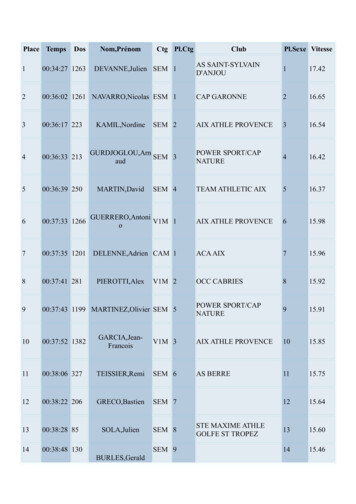

![[SEM] Structural Equation Modeling - Stata](/img/31/sem.jpg)

